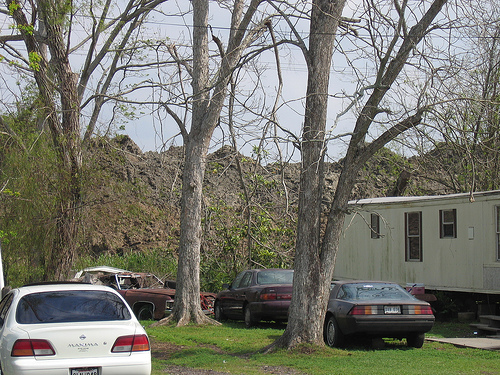Plaquemines community opposes new landfill permits
30th June 2014 · 0 Comments
By Susan Buchanan
Contributing Writer
Looking out his back door, Allen Green of Oakville Community Action Group in Plaquemines Parish sees a mountain of debris and trash. “It’s a smelly, 60-foot eyesore,” he said last week. His ancestor founded the African-American settlement of Oakville in 1869. “Today they wouldn’t let homes be built here,” he said. Oakville, 10 miles south of the Naval Air Station Joint Reserve Base in Belle Chasse, contains more than 150 people in houses and trailers adjacent to the dump.
Nothing has come of promises by elected officials to shut the landfill, which opened 30 years ago, Green said. “Residents have spoken out and written everyone we could think of,” he said. At this juncture, landfill operator Riverside Recycling & Disposal, LLC in Belle Chasse is trying to get a renewal on a state Dept. of Environmental Quality landfill permit, which will be good for another 10 years. On June 17, DEQ held a public hearing in Belle Chasse about the company’s Type III landfill permit application. About 40 people, either for or against the dump, attended. Green said as Oakville residents battle the site, some business owners in the area support it. DEQ is soliciting comments on the company’s permit request until July 17.
The landfill dates to 1985. In August 2004, DEQ issued a permit to Industrial Pipe, Inc. in Belle Chase for a Type III construction and demolition landfill and woodwaste facility, with a 65.7-acre disposal area, Tim Schotsch, Riverside Recycling’s general manager, said last week. Riverside, the landfill’s operator since 2007, filed a permit renewal application in April 2013 with a disposal area of 50.5 acres. “This reduction in disposal area represents an approximate 25-percent decrease in capacity and was the result of a federal levee constructed in the landfill’s permitted boundary,” Schotsch said. The Army Corps of Engineers’ West Bank and Vicinity levee project starts in St. Charles Parish and ends at Oakville.
“Our DEQ renewal application was submitted with no changes in hours of operation, daily capacity, landfill height, waste acceptance, or vehicle entrance and exit to Highway 23,” Schotsch said.
Meanwhile, court battles have raged for years over whether two parcels of floodplain within the landfill’s DEQ-permitted operating area will be given a coastal use permit. Schotsch said Riverside hasn’t used the 8.3 acres that lie in the parish’s floodplain since his company began operating the dump in 2007.
But Industrial Pipe, the landfill’s owner, keeps seeking a coastal use permit or CUP for two floodplain tracts. “Industrial Pipe was filling a 5.3-acre tract with waste in wetlands illegally, without a permit, until the Army Corps issued a cease-and-desist order for Clean Water Act violations” in 2002, Corinne Van Dalen, attorney with Tulane Environmental Law Clinic, said last week. In that April 23, 2002 order, the Corps halted landfill activities on the 5.3 acres. In 2011, Industrial Pipe applied for a CUP for that section, however. Continued legal proceedings are because of Industrial Pipe’s desire for a CUP.
“Industrial Pipe wants a CUP so it can resume filling the 5.3 acres,” Van Dalen said. “And the company wants to start excavating and filling the other three-acre tract, which is forested wetland that hasn’t been used for landfill to date.” She said the Army Corps won’t issue a Clean Water Act 404 permit for the 8.3 acres unless Industrial Pipe gets a coastal use permit.
On June 4, Tulane Environment-al Law Clinic challenged a May 24 decision by Louisiana’s Fourth Circuit Court of Appeal, okaying Industrial Pipe’s request for a CUP. The court is located on Royal St. in the French Quarter. “The May 24 decision isn’t final because this month we asked for a rehearing by the entire Fourth Circuit panel of judges,” Van Dalen said last week. “No decision has been made on our rehearing request.”
The existing landfill is surrounded by fences or natural barriers, including canals and ditches, according to Schotsch. Under the state’s sold waste regulations, Type III landfills must have a 50-foot buffer zone to protect residents.
“But all that’s really separating Oakville from the landfill is a ditch,” Green said. “At one time, there were 250 feet between the community and the landfill,” he said. “Now we have trailers up against the ditch, and landfill is just on the other side of it.” Parents forbid their kids from playing in the ditch, which residents suspect contains toxic metals and other contaminants. “But kids will be kids, and we’ve found toys there,” Green said.
The ditch overflows in heavy rainfall, spreading contaminants across the community, Green said. Much of Oakville, including the ditch, was covered with 3.5 to four feet of water from Hurricane Isaac in 2012.
The dump encroaches on residents with odors, dust, smoke, rodents and vibrations from trucks and equipment, Green said. “You get a whiff of trash when the wind blows your way. It’s unbearable during the change of weather in the fall, when the dump gives off a rotten egg smell for days. You try to stay indoors, but can’t escape the smell.” Some residents suffer from asthma and respiratory ailments year-round. “A number of Oakville men who worked at the landfill died from cancer,” Green said. “We can’t confirm their deaths were related to the dump but we have to wonder.”
Major fires have broken out as underground hotspots cause combustion, Van Dalen said. “In the spring of 2006, debris deposited after Katrina in 2005 burned for over a month,” she said. According to LDEQ, that conflagration, which began in the landfill’s woodpiles, extended from March 9 to April 13, 2006. More recently, a resident in early April 2011 reported a fire that continued for days, according to a DEQ incident report.
Oakville also contends with noise and vibrations from vehicles and equipment. “Our homes shake, and the walls sometimes crack from trucks and bulldozers,” Green said. “But it hasn’t been as bad since the landfill rerouted 18-wheelers away from our community about seven years ago.”
Foul-smelling gas from landfills often contains hydrogen sulfide and sulphur dioxide. Van Dalen said the New Jersey township of Roxbury was plagued by hydrogen sulfide odors after the Fenimore Landfill accepted debris from Hurricane Sandy in 2012. Hydrogen sulfide, sometimes called sewer gas, is flammable and colorless with a rotten egg smell. Prolonged exposure can cause nausea, tearing of the eyes, headaches, loss of sleep and bronchial constriction, according to the U.S. Occupational Safety and Health Administration.
Oakville, meanwhile, is girding itself for an extended confrontation. “The landfill is planning on another ten years at least,“ Green said last week. “I’ve been fighting this dump for a long time, and I’ll continue to fight until they close it down.”
Green’s great grandfather, Leon Sarpy, planned Oakville in 1869, and African Americans from the nearby Sarah and Live Oak Plantations were among its first residents. The St. Peter Baptist Church of Oakville opened its doors in 1874. More than a century later, Industrial Pipe began landfill operations next to the community in 1985.
This article originally published in the June 30, 2014 print edition of The Louisiana Weekly newspaper.




